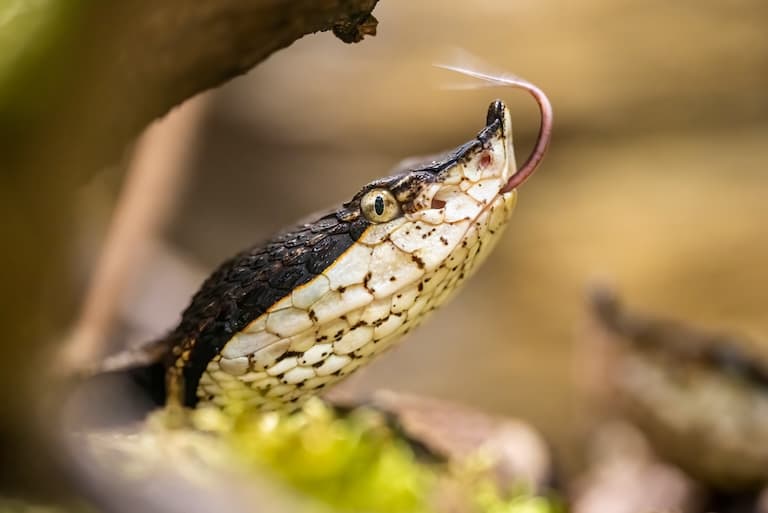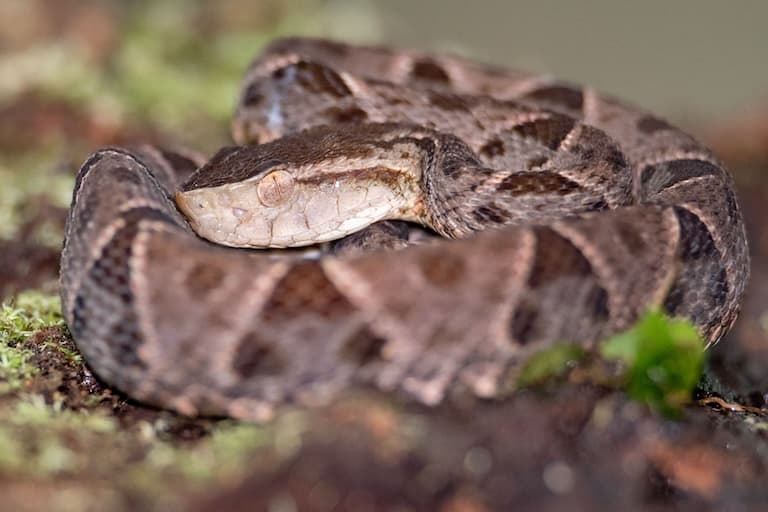Hundred Pacer Profile
Kill Bill was probably the most comic-book-inspired work of enjoyable brutality from Tarantino since Pulp Fiction, and it was one that was very heavy on the snake metaphors.
The most obvious being the nicknames of the assassins: Black Mamba, Copperhead, Cottonmouth and California Mountain Snake; the latter (played brilliantly by Pris from Blade Runner – and whose flappy demise is a tribute to her), has her eye plucked out by the protagonist in a motion that also mimics the strike of a snake.
But there are more subtle tributes to the way of the snake, too, not least the five-point palm technique which, when employed correctly, gives the victim five paces before their hearts explode.
The so-called Hundred pacer, also known even as the five-pacer snake, is a reference to the same principle, and a nod to the lethality of this animal as – so they say – this is how far you might make it after it bites you.

Hundred Pacer Facts Overview
| Habitat: | Moist, shaded habitats: wooded mountain slopes, rocky hillsides, brushy valleys |
| Location: | Eastern China Taiwan, Vietnam |
| Lifespan: | Estimated 20 in the wild; 16 in captivity. |
| Size: | Up to about 1.41 metres (4.6 ft) long |
| Weight: | Nor reported |
| Colour: | Black head, with triangular patterns of dark brown and yellow-brown down the back |
| Diet: | Small mammals, birds, and frogs |
| Predators: | None, other than its own species |
| Top Speed: | Unknown |
| No. of Species: | 1 |
| Conservation Status: | Vulnerable |
The name “Chinese moccasin” doesn’t have the same terrifying ring to it as “five-pace pit viper”, but does refer to the same animal.
This is a small-ish, reasonably dangerous viper species whose athleticism, strength and tenacity make them a tough animal to handle.
Still, their lethality is unquestionably overblown, and of the most dangerous snakes, they sit low on the list. So, let’s see what they’re all about.
Interesting Hundred Pacer Facts
1. They’re pit vipers
The Crotalines, much like the Krays, are a notorious family, mostly for being rather dangerous when cornered. This is the family of snakes that contains the rattlesnakes, copperheads and cottonmouths.
These are the pit vipers, and our friend the “hundred pacer” is a member of this infamous group, policing the Est Asian territories of Eastern China, Vietnam and Taiwan.
Like all pit vipers, they have heat-sensing holes, or pits, in their snouts that allow them to see in the dark, and like so many, the hundred pacer has that characteristically upturned snout, which gives it some of its many nicknames.
Names for this snake include sharp-nosed viper, snorkel viper, and the Chinese moccasin, which sounds positively pleasant, but some less-optimistic name schemes include the hundred-pace pit viper and the five-pace pit viper, pointing to the myth that when bitten by this powerful snake, you have to button up your shirt, make a nod of approval to your assassin, then turn and walk five paces to the soundscape of Ennio Morricone before promptly dropping dead in the sand.
We’re about to touch on whether this is artistic license or gospel truth, but first, let’s see what the snake has to say about it.

2. They rattle
Well, kinda. Being a pit viper this species does have a tendency to wiggle its tail. Lots of vipers do this, the most well-known being the one with the noisy rattle at the end that gives off a terrifying buzz as a warning.
Hundred pacers don’t have the rattle, but they will shake what their mother gave them with quite a scary amount of enthusiasm and the message is clear. But more than this, their defence pose is a thing of true beauty.
This muscular animal holds itself off the ground, facing off threats, not as eager to flee as some of the other species it shares a habitat with.
This, and the fact that they are more active at night, is what makes them so dangerous to people. 1
3. Death Receptors
Cellular biology is a discipline dominated by that small overlapping niche of heavy metal nerds. This is because the cellular processes are some of the most metal in biology. For example, when a virus, like the cold or flu gets into your cells and those cells identify it, they blow themselves up.
But they also blow themselves up when they reach the end of their functional use, and this is how cells regenerate and stay healthy without just multiplying all over the place (one of the hallmarks of a cancer is the lack of this cell death process).
In order for this process to occur, there are specific receptors in the cell membrane called cytokine receptors, and a subgroup of these are responsible for mediating the suicidal cellular behaviours are known as death receptors.
Aside from being an awesome band name, they basically tell a cell when enough is enough and it’s time to do a Logan’s Run and get in the Carousel.
This is relevant because in controlled tests, venom from the hundred pacers was shown to have a protein that triggers these death receptors and initiates cell death. This is usually a bad thing, but in the aforementioned cancers, it can be extremely good.
Just to throw in another heavy metal cell bio term, executioner caspases are also involved. These jump in once cell death is initiated and begin digesting all the bits for reuse elsewhere. 2

4. They’re not so potent
Ironically, in some contexts, the reputation of this snake has become more dangerous than it is. After being told you’ve got seconds to live, it might seem sensible to lop off a bitten finger and try to save yourself from this terrifying fate.
And so, some victims have amputated bits of themselves, sometimes even whole limbs, when in reality, death from this species isn’t all that likely.
Antivenoms are available, and the venom itself isn’t really potent enough to warrant such a lethal reputation, so a person should have plenty of time to reach treatment.
It’s hard to find reliable sources for just how lethal they can be, but of the “Top Five” most dangerous snakes in Taiwan, this species is said to have the least potent venom.
Bites are said to be immediately painful, and followed by considerable swelling, blistering, necrosis, and ulceration.
Systemic symptoms will come next, and heart palpitations can show up early. One confounding variable is the large size of the fangs and the relatively healthy dose of venom the snake can administer.
Still, as with most vipers in the family, deaths are not guaranteed, and while plenty of damage can occur – and lethal bites do happen – it’s not even likely, especially with treatment. 3
5. They can spray shit
One thing you should worry about when messing around with this species is getting a nice jet of snake poo in your eyes.
Snake poo is some of the least pleasant of all the poos, and resembles a mix between rotting cadaver and your bog-standard crap.
So-called cloacal discharge (another black metal band name) has been observed in this species, and involves the ejection of whatever was in the snake’s butthole at the time, apparently over a “considerable distance”.
So, keep that in mind. [noteJennifer Vicente “Deinagkistrodon acutus Chinese Moccasin”, Animal Diversity Web.[/note]
6. More people eat them
The Chinese are well known for their sexual struggles. It seems impotence is such an issue in the world’s most populous country they have resorted to all sorts of strange remedies, often involving the removal of a body part from an endangered animal.
The Han Chinese don’t even bother with drying and grinding a dead viper, it is apparently potent enough just to throw it in a jar of alcohol and slap an “aphrodisiac” label on it.
Needless to say, there are better ways to wake the old chap up for an outing, and it seems unlikely that neither the prospect or act of drinking snake juice is going to be wetting any panties, either. But Chinese medicine will Chinese medicine, and this is contributing to the decline of the species.
Taiwan once boasted their own vast range of snake shops for these very purposes, but today also hosts genuinely useful practices for using the species as a way to make antivenom.
A local aboriginal poet, Malieyafusi Monaneng, wrote of the snake:
“We Paiwan worshipped its eggs as our ancestors,
But now they’ve put it in a medicine jar
As a tool to excite urban lust”
Habitat fragmentation and loss are also affecting the snake, and as this species declines, it’s now listed by the IUCN as Vulnerable, showing that humans have far less to fear from the viper than the other way around. 4

Hundred Pacer Fact-File Summary
Scientific Classification
| Kingdom: | Animalia |
| Phylum: | Chordata |
| Class: | Reptilia |
| Order: | Squamata |
| Family: | Viperidae |
| Genus: | Deinagkistrodon |
| Species: | acutus |
Fact Sources & References
- Chandler’s Wild Life (2022), “1 Bite = 100 Steps Left.”, YouTube.
- “Chinese farmer cuts off finger after being bitten by snake. Doctors tell him he needn’t have bothered”, mynews.
- Kae Yi Tan (2022), “Sharp-nosed Pit Viper (Deinagkistrodon acutus) from Taiwan and China: A comparative study on venom toxicity and neutralization by two specific antivenoms across the Strait”, Science Direct.
- “Chinese Moccasin”, IUCN Red List.
